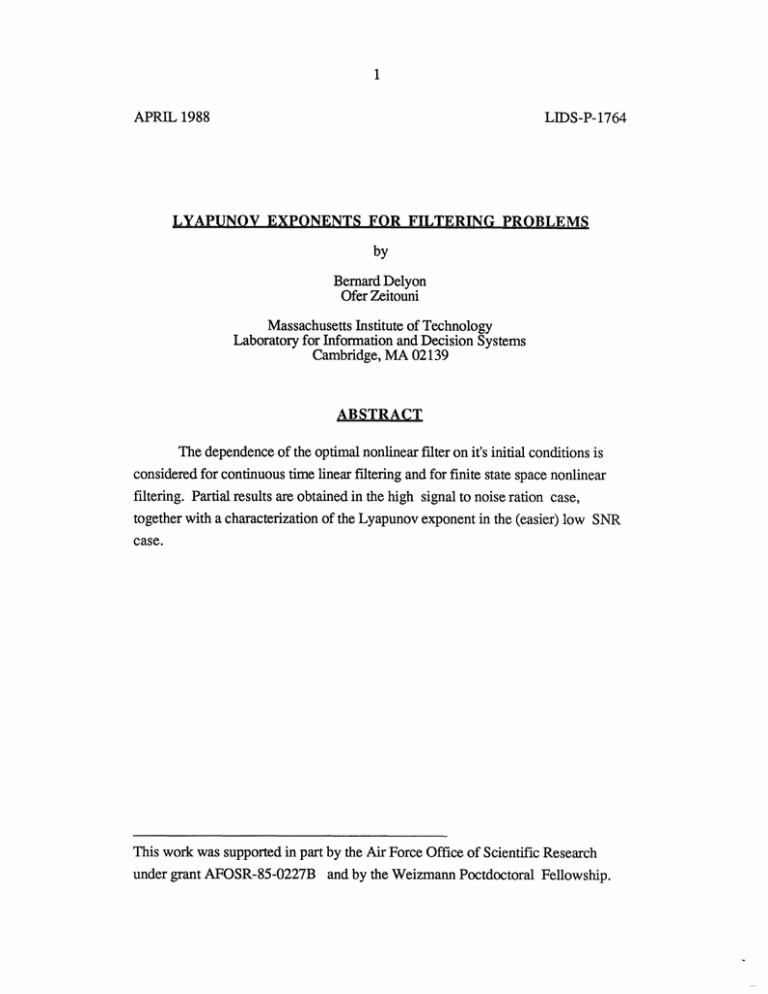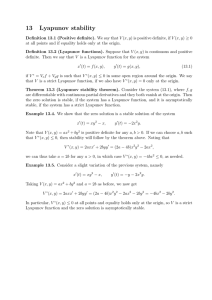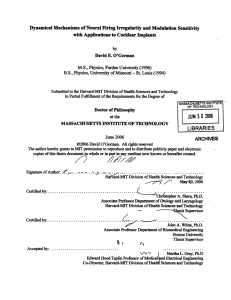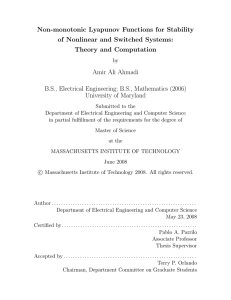APRIL 1988 LIDS-P-1764 by Bernard Delyon
advertisement

APRIL 1988
LIDS-P-1764
LYAPUNOV EXPONENTS FOR FILTERING PROBLEMS
by
Bernard Delyon
Ofer Zeitouni
Massachusetts Institute of Technology
Laboratory for Information and Decision Systems
Cambridge, MA 02139
ABSTRACT
The dependence of the optimal nonlinear filter on it's initial conditions is
considered for continuous time linear filtering and for finite state space nonlinear
filtering. Partial results are obtained in the high signal to noise ration case,
together with a characterization of the Lyapunov exponent in the (easier) low SNR
case.
This work was supported in part by the Air Force Office of Scientific Research
under grant AFOSR-85-0227B and by the Weizmann Poctdoctoral Fellowship.
2
1. INTRODUCTION
In this note, we consider the dependence of the conditional density in the
nonlinear filtering problem on the initial a-priori distribution of the state. From a
practical point of view, one is often interested in knowing how long does he have to
wait to reach near optimality when initiating the optimal filter with the wrong initial
conditions.
Our purpose in this note is mainly to expose the problem. Despite our
efforts, we have at the moment only very partial results, mainly of an asymptotic
nature, which will be explained below. Even those results, however, exhibit
interesting features: it turns out that, at the limit of high signal to noise ratios,
structural properties of the process and mainly of its observations dominate the
memory length.
The models we consider are of one of the following types:
(a) Finite state space in white noise. The state process x is a
continuous time, ergodic, stationary Markov chains with values {1,2,...,k}, and
with an infinitesimal generator G = {gij I 1<ijk, where if Pij(e) = P(x(t+£) = j I(x(t)
= i), then
Pii(£) = 1 + gii£ + o(£)
Pij(6) = ogije + (e)
(1.1)
j # i
The observation process {Yt, t>_0} satisfies
1/2
dyt = h(xt)dt + No dbt
(1.2)
where bt is a one dimensional Brownian motion independent of xt and h =
{h(i) }l<ig is a given vector.
(b) Rational Gaussian process in white noise. The state process
xt e R n satisfies the linear, stochastic differential equation
dx = Axtdt + Bdwt, p(x0 ) = N(mo, P 0 )
(1.3)
3
with wt being an n-dimensional Brownian motion, A,B given constant matrices of
appropriate dimensions, and p(xo), the initial a-priori density of xo, is normal with
mean mo and covariance matrix Po. The observation process Yt e R m satisfies
1/2
dy t = Cxtdt + N 0 db t
(1.4)
where here bt is an m-dimensional Brownian motion independent of xt and C is
again a constant given matrix.
(We remark that a natural candidate for model instead of (1.3), (1.4) is the
general diffusion nonlinear filtering problem; a remark concerning it can be found in
the end of section 3).
We define now the notion of "memory length". In both cases, let
Po
A
(1.5)
Pt (x) = PP(xt = xly s, O<s<t)
denote the conditional distribution (density in case b) of xt, given an initial a-priori
distribution (density in case b) po.
The "memory length" y is defined as follows:
(casea)
Ai1
y= sup limsup -log
P0P0 t-
Po
liP t -P
Po
(1.6a)
oo
where II II denotes the Euclidean norm and
(case b)
y - sup
mn
0 rb
lim sup t log llN t(mo, Po) -
t(mO, po)ll
(1.6b)
eK t --)
where xt(mo, po) is the conditional mean starting from N(mo, P0) and K is some
compact set. In both cases, y is a reminiscent of the usual definition of Lyapunov
exponents. In (1.6b), we consider xt because, the conditional density being
Gaussian, it best characterizes the distribution. We could also allow Po to change,
for brevity we do not do that here, even though the analysis is exactly the same.
In both cases (a), (b), as No -- 0, y will tend to the closest to zero (in real
part) negative eigenvalue of G in case a and pole in case b. As NO -- 0, ("high
signal to noise"), surprisingly, y -) -c necessarily (this is however the case when
4
n=m=l, CAO in case (b) and k=2, hl-h2 is case (a)). For case a, we provide an
example where y - Oas No -- 0, whereas in case (b), the complete analysis of
section 3 shows that if the "transfer function" of (1.3), (1.4) possesses zeroes on
the imaginary axis, y -> 0 as No-- 0, and otherwise y - -oo as No -- 0. Thus,
structural properties of the system involved determine it's "forgiveness" of initial
mistakes, even in high signal to noise ratios!
The remain of the paper in organized as follows: in section 2, case a is
presented; the analysis as No -> oo, an example with y -- 0 as No -e 0 and the k=2
cases are considered. The difficulties in the general case are also pointed out. In
Section 3, the Gaussian case b is presented, with the full asymptotic analysis of No
--
0.
Acknowledgements.
discussions.
We wish to thank Prof. A. Willsky for many fruitful
5
2.
FINITE STATE
SPACE CASE
In this section, we consider case a. We start by considering the 'highnoise" behavior:
Theorem 1: If the process xt is ergodic, there exist two positive constants c and
K 0 such that , for No > K0 ,
11< - £
1 logllpPt
lim
a.e.
(2.1)
t -- oo
Moreover, as No -- oo, E - Xmax(G), the largest non zero real part of the
eigenvalues of G.
Proof. Let H denote the diagonal matrix with Hii = h(i). Then, from Wonham
[1],
dp t = PtGdt - N' <pt,h>pt(H - <pt,h>I)dt
+ No Pt(H - <pt,h>I)dyt
(2.2)
Note that for proving (2.1), it is enough to consider the equation satisfied by the
derivative qt of Pt with respect to the initial conditions Po in any direction d =
(dl...dk). From (2), one has:
-1
dqt = qtG dt - N0o <qt,h>pt(HI - <pt,h>I)dt
-N1 <pt,h>qt(H - <pt,h>I)dt + No <Pt,h>Pt<qt,h>dt
+ No qt(H - <pt,h>I)dy - No p<qt,h>dyt =
dtP + 1/2t
T
NJ1q1hpj-hI
-1/2
-N O
where dv t =
<qt,h>ptdvt
dyt- <Pt, h>dt
0
is the innovation white noise andh = <h,pt>.
6
dqt = qt(G + NO At)dt + No/ qtBtdv t
qO = d
(2.3)
where At and Bt are two matrix valued measurable processes, and there exists a
constant a depending only on h such that:
IIA 11<co
all t, N o
IIBt 11< a
almost surely (11IIdenotes the usual norm of matrices).
Note that the hyperspace E = {q, <q,l> = 0} (where 1 = (1,....,1)T) is
stable under G, At and Bt because
G1 =0
Atl = (hpt)(H- <pt,h>I)1 = (hpt)(h - <Pt' h>l) = 1
and if qe E:
qBtl = q(H-<pt,h>I)1 - <q,h><pt,l>
= <q,h> - <q,h> = 0
But the constraint on po:
XPo(i) = 1
implies that qo has to be choosen in E, and qt remains in E. Choosing any fixed
orthogonal base in E, (2.3) can be rewritten as:
dq t =
q (G' + No1A t) dt + N-o qt Btdvt
where q't = (q't (1),...,q't(k-1)) is a representation of qt in this base; G', A't and
B't are the matrices associated to the restriction to E of the applications represented
(2.4)
7
by G, At and Bt in the whole space. Moreover, the spectrum of G' is the spectrum
of G without the eigenvalue zero, and then, by the assumption of ergodicity, all the
eigenvalues of G' have negative real part.
Let S be a symetric positive matrix and denote:
T
rt = q'Sq T
-1/2
Ut = rt
q
then:
dr t = q;(G'S + SG 'T + No (AtS + SA;T ))qt dt
+ N 0 1/ 2 qt (BtS +SBIT)q'Tdvt
1 qt B SBt qTdt
+ NO
T
l2S
T
IT
T
= rtut(G'S + S G' + No (2AS + BtSB ))u dt
-1/2
+ 2No
T
rtutBtSu t dvt
using Ito's formula, we get:
d log rt = ut(G'S + SG'T + No (2A'tS + BtSB'tj)u
-1
- 2No (utB' Sut)
2d t +
-1/2
t
dt
T
2No utBtSutdvt
and then:
U(G'S + SG )uT ds
-log rt < 1 log rO + -J
0
t
+-N1 N
t
| u (2A' S + B'SBuT ds
B:SB:ud
0
t
+-
t
uJB' SuT dvs
2No1/2
0
-o
Let Xbe the real part of the largest eigenvalue of G' and choose gt > %, then the
matrix H = G' - PI is still a stability matrix and there exist symetric S such that:
(2.5)
8
HS + SH T = -I
for this choice of S, the second term of (2.5) is bounded by 2ti and the third term is
smaller than N-2 0 cl(S) (where cl(S) is a constant depending only on S). For the
last term, consider the time change:
t
|J
=
(UsBoSu s) ds
0
then, we know that there exists a brownian motion Bt such that:
J
t
u B'SuTdv:=B
0
and then:
1 i u B'SuTdv
t
s
s
s
s
t
IB I <C 2(
Zt
Z
t
0
where c2(S) is constant depending only on S. This proves that the last term tends
to zero as t tends to infinity (if ct is bounded, use the last equality, if zt tends to
infinity, use the last inequality). Finally, we get
lim sup tlog r t < 2g +
t -
N o lcl(S)
oo
and then, by the equivalence of the norms of Rk:
limsup
logllqtll <
+ N o cl(S)
which is arbitrarily close to Xif No is large enough.
We consider next the case No -- O0.For k = 2, equation (2.4) is one
dimensional, A't < 0 and therefore,
9
N -->
(2.6)
One is led to think that this situation is generic; our conjecture is that indeed
it is, under suitable "structural conditions", which we don't know at this point to
specify. The problem is that eq. (2.4) is a Bilinear equation with non-constant
coefficients, and the known methods of computing the Lyapunov exponent fail.
The following counter example demonstrates clearly that (2.4) does not hold in
general without restrictions; actually, in this example, y -- 0!
Consider the four state process with transition matrix:
-1
G=
1
-1 1
(2.7)
c.f. fig. 1. The observation vector is
h(xl) = h(x 3 ) = h, h(x 2 ) = h(x 4 ) = 0
(2.8)
Note that the fact that h(x2) = 0 is not significant, as the addition of a d.c. term to
h(x) does not change the filter's structure. The fact that the observations are the
same for different states is of extreme significant, as the following intuitive
argument demonstrates: indeed, note that as No -- o%, by theorem 1, the Lyapunov
exponent of the optimal filter converges to 1, and the conditional distribution
converges to the stationary distribution regardless of the initial conditions.
However, as No -- 0, consider the two initial conditions:
(1,0,0,0) and (0,0,1,0)
The fact that No -0 Oallows us to track accurately the transitions in the system, but
reveals nothing as to the initial conditions and thus the state estimate will highly
depend on p(O). Thus, we expect that the Lyapunov exponent will go to zero as
No -- 0; the following analysis will show that this is indeed the case. For
simplicity, we make the change of variables:
10
1
Pl(t)
pl(t) + P 3 (t)
P
A(t)=
where
1,
P 4 (t)
P 2(t) + p4 (t)
1
-
1
2
(2.9)
2
Pl = P3 =0
A(t) reflects the "mismatch" with the stationary solution pi = P2 = p3 = p4 = 1/4,
where A=0; we analyze the Lyapunov exponent of A(t), which is easily seen to
have the same behavior as that of x(t). It is easily seen that vt is the same under
, A 3 (0)= (0/2))
initial conditions dl or d3 (which correspond to A 1(0) =
however that, by an easy computation based on (2.2), A(t) satisfies:
A (t)=_1/71 -'/Yt A(t)
where
dyt= [1 +
hi/N
1
dt
1-
h01
/2 tdvt
and Yt is highly oscillatory. Analysing directly eq. (3.4) is rather difficult;
fortunately enough, (3.5) is easy to simulate; for
Al
-
t
lim logllA(t)ll,
the results are summarized in table 1, which agrees with the heuristic analysis
above.
No
10
1
0.2
)~
-1
-0.89
-0.53
0.1
-0.21
0.05
-0.085
Table 1. Lyapunov exponent as function of N01 /2
0.02
-0.021
Note
3. THE GAUSSIAN CASE
In this section, we analyze the "memory length" of the optimal filter for the
Kalman filtering problem (Case b). Surprisingly enough, there are cases where the
memory length does not tend to zero when the signal to noise ratio is high, even in
the fully observable case, c.f. below.
We assume throughout that the pair (A,C) is observable and that (A,B) is
stabilizable (c.f. [2]).
Our results are summarized below:
Theorem 2:
a)
For No -- oo,
- Xmax (A), where Xmax(A) is defined as in
Theorem 1.
b)
For NO -- 0, let 4(s) = det (sI-A),
H(s) = C(sI-A)- 1B
Let
e
A {lIRe 0 < 0,
O
(s) 0(-s) det[H (s)H(s)] = 0}
Then y -- (max(0), where
emax(0) is the element of e with largest real
part.
Proof. The optimal filter equations are (c.f. [5]):
dx= Axtdt + K(t)[dy t - C tdt]
(3.1)
where K(t) = P(t) CT/No and
P(t) = AP(t)+
tT
+T
P(t)A +BB
-
PCTCP
N
o
Under our assumptions, P(t) -- Po,. Note that (3.1) implies that, if we denote by
x t(xo) and x t(X0) the output of the filter with x o(Xo) o = x , x o(X5 ) = xo and by
At
(X)
- x t(Xo ), then
T
A=AA- P(t)CC
N
0
from which (a) follows from the boundedness of P(t) and NO- oo.
(3.2)
12
To see (b), we consider first the case of P(O) = Po; in that case, (b) is a
rephrasin of [2, theorem 4.13]. In the general case (P0 = 0), let
P(t)-P
IICTCll <eforallt>T}. Fort > Tone has
T =inftl IP-PNo
At A
P
c
A ~0
A~t=
(P(t) -P )
A
t
T
No
=(A - 00 Cc)At - K
(3.6)
and IIK tl < E.
By the argument below (2.4) (taking there Bt = 0, No A'= Kt and
G'= A -
PooCTC
N
), one obtains that
i p
;max
CTC
A -N P O
<X< X max A-
1
- eeC
N
+ £C
where C1 depends on G' and is independent of E and where Xmax(A
denotes the largest real part of the eigenvalues of A -
-NP
)
PCTC
N O which is negative by
the stability of the optimal filter ([2]). Taking e - Oleads to X= Xmax(A P.CTC
No
). Taking now No -> 0 yields the theorem.
11
We remark that the theorem implies that even for a stable, controllable and
fully observable system, the limiting Lyapunov exponent can approach zero even
with "good measurements": simply, take a system with a transfer matrix zero on
the imaginary axis.
A remark on the general nonlinear filtering problem for diffusions seems in
order here: in many cases, the optimal nonlinear filter is well approximated when
13
N o - 0 by a linear system: c.f. [3], [4]. In those cases, also the "memory length"
y will exhibit the behavior as above. We omit the details here.
14
REFERENCES
[1]
Wonham, W.H., Some Application of Stochastic Differential Equations to
Optimal Nonlinear Filtering - J. SIAM Control, Ser. A, Vol. 2, No. 3,
1965.
[2]
Kwakernaak, H. and Sivan, R., Linear Optimal Control Systems, Wiley,
1972.
[3]
Bobrovsky, B.Z. and Zakai, M., "A lower bound on the estimation error
for Certain Diffusion Processes", IEEE Trans. Inf. Theory, Vol. IT-22,
1976, pp. 45-52.
[4]
Zeitouni, O. and Dembo, A., "On the Maximal Achievable Accuracy in
Nonlinear Filtering Problems", to appear, IEEE Trans. Aut. Control, 1988.
[5]
Gelb, A., Applied Optimal Estimation. MIT Press, Cambridge, MA, 1974.







